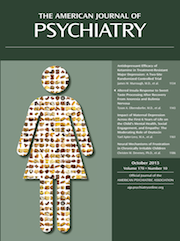Alterations in Brain Structures Related to Taste Reward Circuitry in Ill and Recovered Anorexia Nervosa and in Bulimia Nervosa
Abstract
Objective
The pathophysiology of anorexia nervosa remains obscure, but structural brain alterations could be functionally important biomarkers. The authors assessed taste pleasantness and reward sensitivity in relation to brain structure, which may be related to food avoidance commonly seen in eating disorders.
Method
The authors used structural MR imaging to study gray and white matter volumes in women with current restricting-type anorexia nervosa (N=19), women recovered from restricting-type anorexia nervosa (N=24), women with bulimia nervosa (N=19), and healthy comparison women (N=24).
Results
All eating disorder groups exhibited increased gray matter volume of the medial orbitofrontal cortex (gyrus rectus). Manual tracing confirmed larger gyrus rectus volume, and volume predicted taste pleasantness ratings across all groups. Analyses also indicated other morphological differences between diagnostic categories. Antero-ventral insula gray matter volumes were increased on the right side in the anorexia nervosa and recovered anorexia nervosa groups and on the left side in the bulimia nervosa group relative to the healthy comparison group. Dorsal striatum volumes were reduced in the recovered anorexia nervosa and bulimia nervosa groups and predicted sensitivity to reward in all three eating disorder groups. The eating disorder groups also showed reduced white matter in right temporal and parietal areas relative to the healthy comparison group. The results held when a range of covariates, such as age, depression, anxiety, and medications, were controlled for.
Conclusion
Brain structure in the medial orbitofrontal cortex, insula, and striatum is altered in eating disorders and suggests altered brain circuitry that has been associated with taste pleasantness and reward value.



